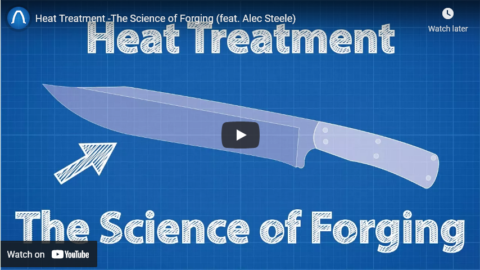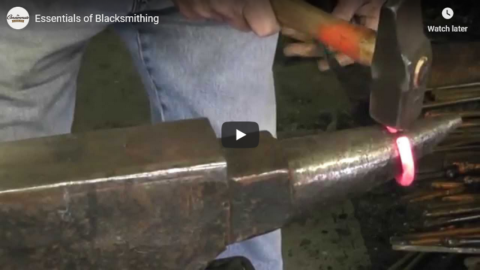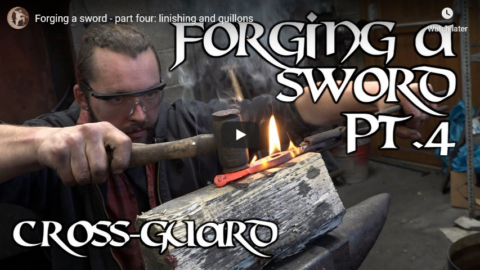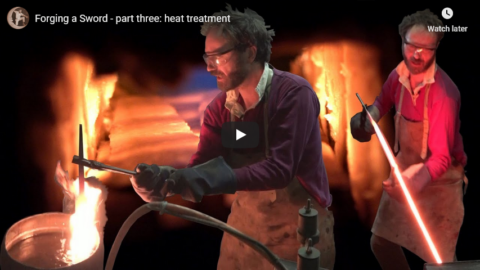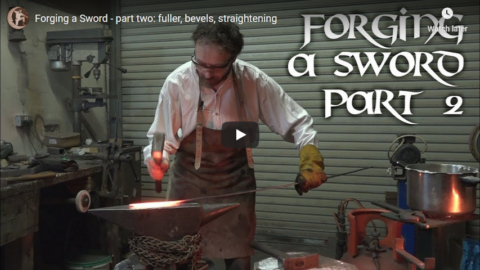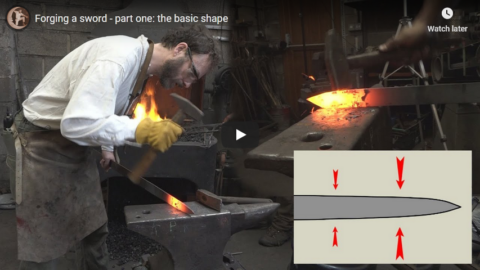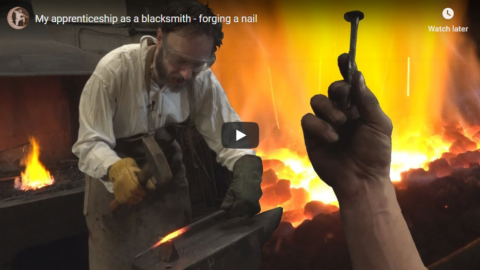Kevin R. Cashen
Published 18 Jan 2018Master bladesmith Kevin Cashen makes a forged kukri (khukuri) from start to finish.
Note — A common comment is on the spelling of the knife, I hope I can clear this up with a post more people can see before commenting — I do not feel that I am qualified to call myself a khukuri maker, so I prefer to title my blade with the Anglicized version out of respect to the craftsmen of Nepal.
August 3, 2022
The making of a Cashen kukri
August 1, 2022
I Accidentally Made…
Jill Bearup
Published 4 Apr 2022I spent two days with a blacksmith learning to make a knife. How did it turn out? Well … not quite as I pictured it? But still pretty great.
(more…)
July 14, 2022
Frontier Blacksmith: A Day in the Life – Decorative Blacksmithing
Townsends
Published 26 Mar 2022
(more…)
June 17, 2022
QotD: The work of the blacksmith
There are a few basic behaviors of iron that fundamentally control what blacksmiths are going to do with it in this stage. To begin with, we need to introduce some terminology to avoid this coming confusing: a given piece of metal can be hard (resistant to deformation) or soft; it can also be ductile (able to deform significantly before breaking) or brittle (likely to break without deformation). This is easiest to understand at the extremes: a soft, brittle material (like a thin wooden dowel) takes very little energy and breaks immediately without bending, while a hard, ductile material (the same dowel, made of spring-steel) bends more easily under stress but resists breaking. But it is also possible to have hard brittle materials (pottery being a classic example) which fiercely resist deforming but break catastrophically the moment they exceed their tolerances or a soft, ductile material (think wet-noodle) which bends very easily.
(I should note that all of these factors are, in fact, very complex – far more complex than we are going to discuss. In particular, as I understand it, some of what I am using “hardness” to describe also falls under the related category of yield strength. Hopefully you will all pardon the necessary simplification; if it makes you feel any better, ancient blacksmiths didn’t understand how any of this worked either, only that it worked.)
Of course these are not binaries but a spectrum. Materials have a degree of hardness or ductility; as we’ll see, these are not quite opposed, but changing one does change the other – increasing hardness often reduces ductility.
The sort of things that pre-modern people are going to want to be made in iron are going to have fairly tight tolerances for these sorts of things. Objects that had wide tolerances (that is, things which could be weak or a little bendy or didn’t have to take much force) got made out of other cheaper, easier materials like ceramics, stone or wood; metals were really only used for things that had to be both strong and relatively light for precisely the reasons we’ve seen: they were too expensive for anything else. That means that a blacksmith doesn’t merely need to bring the metal to the right shape but also to the right characteristics. Some tools would need to finish up being quite hard (like the tip of a pick, or the edge of a blade), while others needed to be able to bend to absorb strain (like the core of a blade or the back of a saw).
Bret Devereaux, “Collections: Iron, How Did They Make It, Part III: Hammer-time”, A Collection of Unmitigated Pedantry, 2020-10-02.
April 19, 2022
QotD: “Bog iron” in ancient and medieval society
There are quite a lot of ores of iron, but not all of them could be usefully processed with ancient or medieval technology. The most commonly used iron ore was hematite (Fe2O3), with goethite (HFeO2) and limonite (FeO(OH)·nH2O) close behind. Rarer, but still used was magnetite (Fe3O4) and siderite (FeCO3). All of these can occur in big rock deposits, but may also occur as “bog iron” where oxidation occurs in acidic environments (in swamps and bogs) leading to the formation of small clumps of iron-rich material. Many of these ores can be spotted visually by someone who knows what they are doing; hematite can be blackish to reddish-brown but leaves tell-tale red streaks (of rust); goethite’s black-brown color is also fairly recognizable, as is limonite with its burnt yellow-orange hue. We’ll come back to these ores a few times both this week and next, because while they can all yield iron, some of them yield that iron easier than others.
One distinction here is between bog iron and iron in ore deposits. Bog iron is formed when ground-water picks up iron from iron-ore deposits, where that iron is then oxidized under acidic conditions to form chunks of iron minerals (goethite, magnetite, hematite, etc.), typically in smallish chunks. Bog iron is much easier to smelt because it contains fewer impurities than iron ore in rock deposits, but the quantity of iron available from bog iron is relatively low (although actually renewable, unlike mines; a bog can be harvested for iron again after a few decades as the processes which produce the bog iron continue). Because of its low output, bog iron tends to be an important part of the iron supply only when production is relatively low, such as during the Pre-Roman Iron Age in Europe, or the early medieval period.
But what I want to stress here at the outset is that while the local variety of iron may vary based on conditions, iron ores are sufficiently common that prior to the industrial revolution, it wasn’t generally necessary to trade or transport them over long distances because most areas have deposits. There are some exceptions (Japan is notoriously mineral poor – my limited geological understanding is that this is common in volcanic land formations – and while it does have some iron deposits, they are few and relatively small), but for the most part, getting iron ore was not hard. As we’ll see, timber availability was actually often a more pressing limitation on iron exploitation than the ore itself […]
Bret Devereaux, “Iron, How Did They Make It? Part I, Mining”, A Collection of Unmitigated Pedantry, 2020-09-18.
April 10, 2022
QotD: Most MMORPG portrayal of iron-working is incredibly unrealistic
As with our series on farming, we are going to follow the train of iron production from the mine to a finished object, be that a tool, a piece of armor, a simple nail, a weapon or some other object. And I want to stress that broad framing: iron was made into more things than just swords (although swords are cool). If you are here wondering how you go from iron-bearing rocks to a sword, these posts will tell you, but they will equally get you from those same rocks to a nail, or a workman’s hammer, or a sawblade, or a pot, or a decorative iron spiral, or a belt-buckle, or any other of a multitude of things that might be produced in iron.
Iron production is a unique topic in one key way. If the problem with farmers is that the popular understanding of the past (either historical or fantastical) renders them effectively invisible – as indeed, it tends to render most ancient forms of production invisible – iron-working is tremendously visible, but in a series of motifs that are almost completely wrong. Iron is treated as rare when it is common, melted in societies that almost certainly lack the furnaces to do so; swords are cast when they should be forged, quenched in ways that would ruin them and the work of the iron-worker is represented as a solitary activity when every stage of iron-working, when done at any kind of scale, was a team job (many modern traditional blacksmiths work alone, often as a hobby; ancient smiths generally did not). The popular depiction is so consistently wrong that it doesn’t really even provide a firm basis for correction. We are going to have to start over, from the beginning.
[…]
In most video games, if you are looking to produce some iron things, the first problem you invariably have is finding some iron ores. Often iron is some sort of semi-rare strategic resource available in only certain parts of the map, something that factions might fight over. Actually finding some iron might be a serious problem.
Well, I have good news for historical you as compared to video game you: iron is the fourth most common element in earth’s crust, making up around 5% of the total mass of the part of the earth we can actually mine. Modern industry produces – and I mean this very literally – a billion tons (and change) of iron per year. Iron is about the exact opposite of rare; almost all of the major ores of iron are dirt common. And that’s the point.
One of the reasons that the change from using bronze (or copper) as tool metals to using iron was so important historically is that iron is just so damn abundant. Of course iron can be used to make better tools and weapons as well, but only with proper treatment: initially, the advantage in iron was that it was cheap. Now, as we’ll see, while the abundance of iron makes it cheap, the difficulty in working it poses technological problems; that’s why the far rarer and also generally inferior (to proper, work-hardened, heat-treated iron or steel; bronze will often exceed the performance of unalloyed iron) copper and bronze were used first: harder to find, easier to work. […]
Very small amounts of iron occur on earth as pure “native” metal; the term for this, “meteoric iron” is an accurate description of where it comes from (there is also one known deposit of native “telluric iron“); in practice, the sum total of these iron sources is effectively a rounding error on the amount of iron an iron-age society is going to need and so “pure” iron may be disregarded as a meaningful source of iron.
Bret Devereaux, “Iron, How Did They Make It? Part I, Mining”, A Collection of Unmitigated Pedantry, 2020-09-18.
August 21, 2021
Heat Treatment -The Science of Forging (feat. Alec Steele)
Real Engineering
Published 29 Jan 2018Watch Alec’s 2 part vlog: http://bit.ly/2DVNZrn
Listen to our new podcast at:
Showmakers YouTube channel at: https://goo.gl/Ks1WMpItunes: https://itun.es/us/YGA_ib.c
RSS and Libsyn Audio is available on our site: https://www.showmakers.fm/Get your Real Engineering merch at: https://standard.tv/collections/real-…
Editing Laptop: http://amzn.to/2tipgoI
Camera: http://amzn.to/2ucfWEa
Microphone: http://amzn.to/2uCF8pSPrimary research material: http://digicoll.manoa.hawaii.edu/tech…
Patreon:
https://www.patreon.com/user?u=282505…
Instagram:
https://www.instagram.com/real.engine…
https://www.instagram.com/brianjamesm…
Twitter:
https://twitter.com/Fiosracht
Website:
https://www.RealEngineering.netMy Patreon Expense Report:
https://goo.gl/ZB7kvKThank you to my patreon supporters: Adam Flohr, darth patron, Zoltan Gramantik, Henning Basma, Karl Andersson, Mark Govea, Mershal Alshammari, Hank Green, Tony Kuchta, Jason A. Diegmueller, Chris Plays Games, William Leu, Frejden Jarrett, Vincent Mooney, Ian Dundore, John & Becki Johnston. Nevin Spoljaric
Once again thank you to Maeson for his amazing music. Check out his soundcloud here: https://soundcloud.com/maeson-1/tracks
October 20, 2020
Essentials of Blacksmithing
The Consummate Dabbler
Published 23 Apr 2014My 5 Top Books for Blacksmiths http://bit.ly/1OmoMBY
Details http://bit.ly/1oxQnX2 – A detailed demonstration and explanation of the tools, techniques and methods of a blacksmith. This video provides a thorough education into the basics of what you need to know to become a blacksmith. www.TheConsummateDabbler.com
From the comments:
The Consummate Dabbler
4 years ago (edited)
By request; more blacksmithing information and instructional information:
– 25 of the World’s Most Famous Blacksmiths http://bit.ly/1rv3r35
– 5 Best Books to Learn to Blacksmith http://bit.ly/1OmoMBY
– Anvil Height – How to Get it Right http://bit.ly/1OxOwk3
– Essentials of Blacksmithing – All the Tools and Methods http://bit.ly/1oxQnX2
September 3, 2020
Forging a sword: part five – completion
Lindybeige
Published 5 Dec 2019I make the pommel and the grip, assemble the hilt, and polish it to a shine. Behold: ARNANDER!
Support me on Patreon: https://www.patreon.com/Lindybeige
Many thanks to The Cut And Thrust Collective for inviting me to Glastonbury to have a go at forging a sword.
My tutor: Thom Leworthy.
Music used in this video: “Siegfried’s Funeral March” by Wagner.
Buy the music – the music played at the end of my videos is now available here: https://lindybeige.bandcamp.com/track…
Buy tat (merch):
https://outloudmerch.com/collections/…Lindybeige: a channel of archaeology, ancient and medieval warfare, rants, swing dance, travelogues, evolution, and whatever else occurs to me to make.
▼ Follow me…
Twitter: https://twitter.com/Lindybeige I may have some drivel to contribute to the Twittersphere, plus you get notice of uploads.
My website:
http://www.LloydianAspects.co.uk
August 31, 2020
Forging a sword – part four: linishing and quillons
Lindybeige
Published 6 Apr 2019Forging Arnander, my English bastard sword. I now start linishing (grinding/polishing), and make the quillons (crossguard) in a slightly fancy manner.
Support me on Patreon: https://www.patreon.com/Lindybeige
Had I been a better smith, I could have judged the amount that the quillons would extend by when being hammered out, and there wouldn’t have been the need to grind away so much metal. Without motorised tools, the medieval smiths would want to minimise grinding.
My tutor: Thom Leworthy.
Music used in this video: “Siegfried’s Funeral March” by Wagner.
Buy the music – the music played at the end of my videos is now available here: https://lindybeige.bandcamp.com/track…
More weapons and armour videos here: https://www.youtube.com/playlist?list…Lindybeige: a channel of archaeology, ancient and medieval warfare, rants, swing dance, travelogues, evolution, and whatever else occurs to me to make.
▼ Follow me…
Twitter: https://twitter.com/Lindybeige I may have some drivel to contribute to the Twittersphere, plus you get notice of uploads.
website: http://www.LloydianAspects.co.uk
August 28, 2020
Forging a Sword – part three: heat treatment
Lindybeige
Published 12 Jul 2018Heat-treating a sword is very important, and can easily go very wrong. Here you see my first go at it.
Support me on Patreon: https://www.patreon.com/Lindybeige
No special lightsabre effects were used in this video. It actually looked like that in real life.
Many thanks to The Cut and Thrust Collective:
glastonburysmith@gmail.comBuy the music – the music played at the end of my videos is now available here: https://lindybeige.bandcamp.com/track…
Lindybeige: a channel of archaeology, ancient and medieval warfare, rants, swing dance, travelogues, evolution, and whatever else occurs to me to make.
▼ Follow me…
Twitter: https://twitter.com/Lindybeige I may have some drivel to contribute to the Twittersphere, plus you get notice of uploads.
website: http://www.LloydianAspects.co.uk
August 25, 2020
Forging a Sword – part two: fuller, bevels, straightening
Lindybeige
Published 28 May 2018Sword-smithing again at the Cut And Thrust Collective, working on Arnander, my type 18 bastard sword. Lots of hammering.
Support me on Patreon: https://www.patreon.com/Lindybeige
Part one of forging a sword: https://youtu.be/KYydVZRbl6M
My tutor: Thom Leworthy.
Music used in this video: “Siegfried’s Funeral March” by Wagner.
Buy the music – the music played at the end of my videos is now available here: https://lindybeige.bandcamp.com/track…
Lindybeige: a channel of archaeology, ancient and medieval warfare, rants, swing dance, travelogues, evolution, and whatever else occurs to me to make.
▼ Follow me…
Twitter: https://twitter.com/Lindybeige I may have some drivel to contribute to the Twittersphere, plus you get notice of uploads.
website: http://www.LloydianAspects.co.uk
August 22, 2020
Forging a sword – part one: the basic shape
Lindybeige
Published 8 Feb 2018Hammering hot metal into shape is quite a satisfying task, when it goes well. Here you see me shaping out my sword.
Support me on Patreon: https://www.patreon.com/Lindybeige
I was invited by the Cut and Thrust Collective to go to Glastonbury and make my own sword. In an earlier video, you saw my training (forging a nail), and immediately after that we started on the sword. Thom Leworthy was the bladesmith showing me how it is done.
The Cut and Thrust Collective:
glastonburysmith@gmail.comBuy the music – the music played at the end of my videos is now available here: https://lindybeige.bandcamp.com/track…
Lindybeige: a channel of archaeology, ancient and medieval warfare, rants, swing dance, travelogues, evolution, and whatever else occurs to me to make.
▼ Follow me…
Twitter: https://twitter.com/Lindybeige I may have some drivel to contribute to the Twittersphere, plus you get notice of uploads.
website: http://www.LloydianAspects.co.uk
June 11, 2019
My apprenticeship as a blacksmith – forging a nail
Lindybeige
Published on 16 Jan 2018Before forging my sword, I had to do an apprenticeship as a blacksmith, and make a nail. Here witness my training.
Support me on Patreon: https://www.patreon.com/Lindybeige
I was a guest of The Cut and Thrust Collective – four blacksmiths who have banded together in a forge that was once known as The Forge of Avalon, in Glastonbury. There I spent most of a week, and there I forged my sword – Arnander – the making of which will be the subject of further videos.
I’m quite pleased with the amount of information I got into this video about how forging is done. It shows you several details of how to use a forge to heat metal, and how to hammer shapes into metal.
Many thanks to Joseph McDonald for inviting me in the first place, acting as cameraman, and cooking lots of bacon. Thanks too to my teacher here Thom Leworthy.
The company takes commissions for blacksmithing, and runs courses so that you can go in and make your own pieces. glastonburysmith@gmail.com
Lindybeige: a channel of archaeology, ancient and medieval warfare, rants, swing dance, travelogues, evolution, and whatever else occurs to me to make.
▼ Follow me…
Twitter: https://twitter.com/Lindybeige I may have some drivel to contribute to the Twittersphere, plus you get notice of uploads.
website: http://www.LloydianAspects.co.uk
April 13, 2019
History Summarized: Steel (Feat. “That Works”)
Overly Sarcastic Productions
Published on 12 Apr 2019More from Matt & Ilya on “That Works”: https://bit.ly/2D0A6qk
More about steel from Shadiversity:
— “When Was Steel Invented” https://bit.ly/2uSwcvh
— “The Riddle of Steel” https://bit.ly/2G6TB28
— “The Oldest Steel Sword” https://bit.ly/2VvWVZZCORRECTION from 12:10 — The back of a Katana after differential hardening process is a lower-carbon STEEL, but it is still Steel rather than Iron. My mistake. The higher-carbon content Martensite forms the cutting edge, and low-carbon steel forms the spine.
BLUE’S BOOK: Philosophicalphridays.com
PATREON: https://www.Patreon.com/OSP

